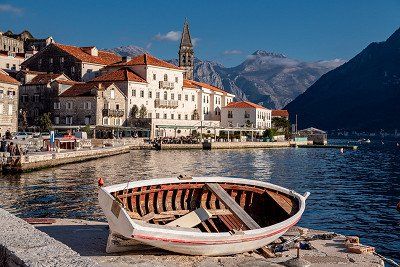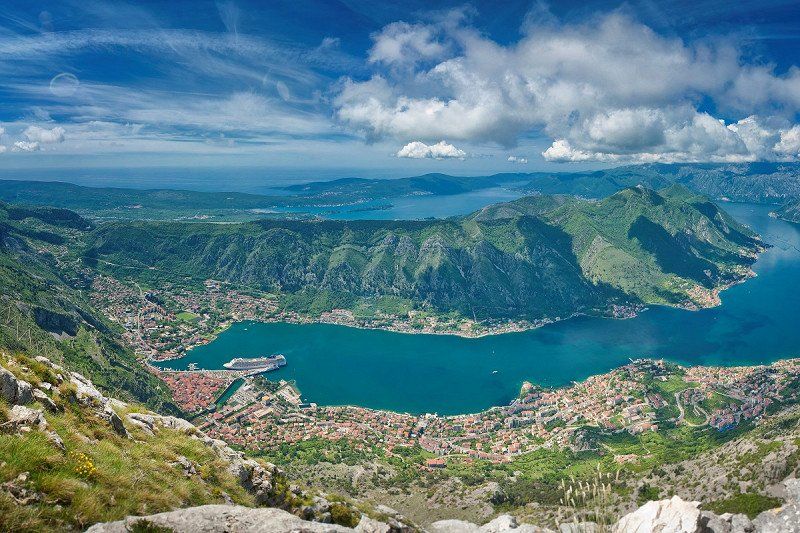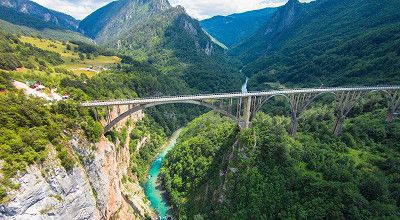Montenegro may be small, but it has so much to offer – and is surprisingly still an insider tip if you want to experience the Mediterranean coast along with untouched mountain landscapes and remarkable culture during your camping holiday. Freeontour has put together the ten best sights and highlights for your next Balkan adventure.
Contents
Where exactly is Montenegro?
When is the best time to go camping in Montenegro?
What can you expect to experience on a camping holiday in Montenegro?
1. Stop over at Durmitor National Park
2. Make a photo stop at the Tara River Canyon, the deepest canyon in Europe
3. Admire Byzantine art in Morača Monastery
4. Explore the natural gem that is Lake Skadar
5. Visit Stari Bar, a city of ruins with a turbulent history
6. Relax on the sandy beach between Ulcinj and Budva
7. Take a selfie at Sveti Stefan
8. Walk through the Old Town of Budva
9. Discover a World Heritage Site in Kotor
10. Marvel at the Ostrog rock monastery

Where exactly is Montenegro?
Once a part of Yugoslavia, Montenegro gained independence in 2006. Today it covers an area of almost 14,000 km², making it one of the smaller states in Europe, yet is home to many cultural influences. Montenegro borders Croatia to the extreme west, Bosnia and Herzegovina to the northwest, Serbia to the northeast, Kosovo to the east and Albania to the southeast. Almost 300 km long with around 73 km of beaches, the Adriatic coast of Montenegro lies between Croatia and Albania. Montenegro has been an official candidate for EU membership since 2010. The euro has been the official currency of Montenegro since 2002, but the country is not in the European Monetary Union. By the way, the official language is Montenegrin, a South Slavic language, as are Serbian, Croatian and Bosnian.

When is the best time to go camping in Montenegro?
The camping season in Montenegro lasts from around April to November on the coast, which has a mild Mediterranean climate with an average of 218 days of sunshine a year. Some campsites are also open all year round. Since it can get very hot on the Adriatic Sea in July and August, the months of May and June as well as September and October are perfect for camping, especially if you don't have air conditioning in your camping vehicle. However, you're likely to encounter colder temperatures and snow on the mountains in the interior in winter. If you plan on exploring the Montenegrin mountains by hiking or mountain biking in summer, you'll also find it slightly cooler there than on the coast.

What can you expect to experience on a camping holiday in Montenegro?
Montenegro may be a small country, but it's full of contrasts. So you can explore a variety of sights and highlights either by travelling around with your motorhome or by leaving your caravan at a campsite and using it as a base. In addition to the Adriatic coast with its turquoise blue rocky bays, sandy beaches and former fishing villages, there are also the black mountains that gave this country its name. And they're not only home to one of the world's deepest gorges and Europe's highest railway bridge, but also to primeval forests, lakes, bears and wolves as well as historic village ruins and an exciting cultural mix of architecture and finds from different eras. In a nutshell, it's very rare to find so many diverse landscapes and cultural testimonies in such a small area as in Montenegro. Freeontour has put together a selection of highlights for inspiration:

1. Stop over at Durmitor National Park
Durmitor is the largest of five national parks in Montenegro. It is peppered with fantastic views of blue mountain lakes, green forests and deep gorges as well as fascinating karst formations and rugged rocks. But gentle, grassy mountains and pretty valleys are also part of its portfolio. Accordingly, Durmitor National Park in the north of the country has been a UNESCO World Heritage Site since 1980 and offers roughly 25 waymarked mountain hiking trails of varying levels of difficulty. Bobotov Kuk (2,500 m) is the highest mountain in the Durmitor massif, which has more than 40 peaks above 2,000 m. It can, therefore, get quite chilly up here in the mountains even in summer (and very white in winter). Rain is also not uncommon outside of the summer months. So make sure that you have sturdy shoes, rain protection and plenty of provisions and drinking water if you decide to go hiking in Durmitor National Park.

If you prefer to explore the national park by car or motorhome, we recommend the Durmitor Ring (Durmitorski prsten). This scenic route, in fact Panoramic Road No. 2, has been signposted since 2020, is 76 km long and goes through both Durmitor National Park and Piva Nature Park. However, some sections of this scenic road are quite narrow and steep, therefore, only suitable for campers with experience in driving on mountains and whose vehicle is shorter than 7 m, no wider than 2.30 m and up to 2.90 m high. This ring road can in principle be driven in both directions, but the official recommendation for motorhomes is to drive clockwise. The best time to drive along this panoramic road is generally between May and October; it is usually closed in winter or after heavy rainfall.
Please note: to enter the national park, you'll have to buy a ticket from a ranger in any of the car parks along the panoramic road, regardless of whether you're on foot or in a vehicle.

2. Make a photo stop at Tara Canyon, the deepest canyon in Europe
Another natural highlight in Montenegro winds its way through Durmitor National Park for almost 80 km: the Tara Gorge along with the river of the same name. Up to 1,333 m deep, it is the deepest gorge in Europe and the second deepest gorge in the world after the Grand Canyon in the USA. The best view of the Tara Canyon is from Đurđevića Tara Bridge, built in 1941. Standing on the roughly 350 m long and 7 m wide arched bridge, you start to realise just how gigantic this canyon is. You can walk up to an even higher vantage point from the car park near the bridge. It might get a bit sweaty, but it's worth it as Đurđevića Tara Bridge will reward you with great photo opportunities. If you're feeling more adventurous, you can book a rafting tour through the canyon or fly from one side of this huge gorge to the other by zip line.
3. Admire Byzantine art in Morača Monastery
One of the lesser-known Montenegrin gems is the small Morača Monastery located on the road between Kolašin and the capital, Podgorica, on the banks of the Morača River. A small waterfall descends into the river next to the monastery, making for a picturesque setting. But wait until you get inside the monastery, which was first built in 1252, burnt down by the Turks in the 16th century and rebuilt at the beginning of the 17th century.
The inside is decorated with frescoes and the church contains masterpieces of Byzantine art, including some 13th-century frescoes as well as frescoes from the 16th and 17th centuries. Morača Monastery also has an unusual collection of icons from the 17th and 18th centuries, some of which adorn the magnificently carved iconostasis, which was made between 1600 and 1617.

4. Explore the natural gem that is Lake Skadar
Podgorica, the capital of Montenegro, has around 186,000 inhabitants. It's not really pretty, but you'll come across a variety of architectural styles that reflect the eventful history of Montenegro. If you don't have that much time, we recommend you concentrate on the area south of Podgorica. Lake Skadar National Park is a true natural gem that most foreign tourists have never heard of. It has a surface area of roughly 370 km² in summer and 540 km² in winter, making it the largest freshwater lake in the Balkans. Stretching from southern Montenegro to northern Albania, the lake is roughly the size of Lake Garda in Italy after the winter ice has melted.

Home to around 280 species of birds, historic towns, sacred medieval architecture and centuries-old vineyards, Lake Skadar National Park also offers many opportunities to actively discover its fantastic nature by or on the water. For instance, you can rent a boat or kayak in Virpazar, the most visited settlement on the lake, or at the visitor centre in Vranjina. Bikes are another great way of exploring the area from the Rijeka Crnojevića river. You'll also find small villages with local wineries and fortress ruins from a bygone era in the fertile hinterland. The national park is perfect for hiking tours in spring and autumn as well. It can get quite, even too, hot here in summer, so an organised boat trip visiting smaller islands with historic monasteries and fortresses, such as the former Ottoman fortress and prison Grmožur, is very much a cooler alternative, especially if you combine the trip with a swim in the lake.
The perfect spot for a plunge is Murići beach on the southwestern shore of Lake Skadar, but the small beaches at Dodoši or Karuč are also charming. In Dodoši you can even jump into the water right from the bridge and then enjoy some sunbathing and local specialities on the nearby terrace of the floating raft restaurant. Incidentally, there are five ornithological stations in the national park for bird watching, which are particularly worth visiting in autumn and winter.

5. Visit Stari Bar, a city of ruins with a turbulent history
About 4 km before the town of Bar, just before you get to the picturesque coastal towns, you'll come upon another historic treasure trove – the ruins of Stari Bar are yet another witness of Montenegro's turbulent history. Some buildings have been restored and turned into a kind of museum city that you can visit for a few euros.
Stari Bar was founded around 2,000 years ago and had more than 4,000 inhabitants at its peak. Over the centuries, the city has been inhabited by the Romans, Byzantines, Serbs and Hungarians before finally falling under the control of the Ottoman Empire. Stari Bar suffered heavily in 1878 during the War of Independence, with much of the town being destroyed. The earthquake that struck the city exactly 101 years later led to the residents abandoning the city once and for all.
And its ruins have been lying dormant ever since. You can still see the aqueduct from the 18th century, a church with a clock tower from the 14th century and a Turkish bath from the 15th century. During World War II, its citadel is said to have served as a prison for fascist traitors.

6. Relax on the sandy beach between Ulcinj and Budva
There are 117 beaches with a total length of 73 km on the Adriatic coast of Montenegro – ranging from long sandy beaches to small rocky bays, there's plenty of space to relax and sunbathe. The longest sandy beach stretching almost 13 km is in the municipality of Ulcinj and a well-known spot for kitesurfing in summer. The golden sandy beach of Sutomore primarily attracts young people from Podgorica and is just a few kilometres north of Bar. The popular resort of Petrovac boasts a reddish sandy beach, while the sandy and pebble beach of Buljarica is mainly unspoilt. You'll find wild and hidden beaches and bays on the coast further towards Budva.

7. Take a selfie at Sveti Stefan
If you're looking for some luxury and a place to sunbathe, then spend a few hours on the beach on the Sveti Stefan peninsula. The reddish sandy beach connects the coast with the small rocky island where you'll find the exclusive city-hotel Sveti Stefan. One part of the beach is for the public, another for hotel guests. Fishermen used to live in the stone houses with bright red roofs on the small peninsula until the 1950s. Today, the entire island is a luxury resort, accessible only to hotel guests or visitors on a guided tour. A selfie or two in front of this Montenegrin landmark is affordable for every budget.

8. Walk through the Old Town of Budva
A word of warning: if you like your holidays peaceful, tranquil and unspoilt, avoid the city of Budva in summer as it has become the holiday hotspot of Montenegro, with tourists flocking to the beaches and the Old Town. However, there's a very different vibe here in winter and in the off-season when you'll be able to experience this coastal town at your own leisurely pace. Budva is over 2,500 years old, making it one of the oldest cities on the Adriatic coast. According to legend, Budva was founded by Cadmus, a Phoenician prince who fled here from Thebes with his wife. The Old Town, which lies on an island off the mainland, is under monumental protection and surrounded by a well-preserved and accessible city wall, which allows for amazing views down into the narrow streets between the buildings. The Old Town also has several interesting historic churches.
If you want to explore the Old Town of Budva without the crowds, come here as early as possible in the morning when the many holiday party-goers are still lying in bed. We recommend taking public transport or a taxi as parking spaces are very rare and traffic is often very heavy – so avoid all the stress and hassle by leaving your motorhome elsewhere.

9. Discover a World Heritage Site in Kotor
There's a good reason why the Old Town of Kotor is a UNESCO World Heritage Site, and you'll notice very quickly what it is once you're here. This is also why it attracts masses of tourists in peak season, and it gets especially crowded when one of the many cruise ships docks in the port. However, it can't be helped as this small town lies at the end of a large bay of the same name, which is often referred to as Europe's southernmost fjord. Accordingly, we recommend visiting Kotor in the off-season. The Old Town is surrounded by an imposing city wall, which is about 5 km long, up to 20 m high and up to 10 m wide. You'll find one of the best preserved medieval cities in the entire Mediterranean within its walls. The museums, churches and palaces in the winding streets and alleys still reflect the major architectural eras of the region. The most famous example is the 12th-century twin-towered Cathedral of Saint Tryphon, but you should also visit the pretty Gospa od Škrpjela Church on the same-named islet just off the coast.
Our tip:if you want to avoid the tourist crowds in Budva and Kotor, head to the Baroque town of Perast in the Bay of Kotor or to Risan, one of the oldest cities on the Adriatic coast.

10. Marvel at the Ostrog rock monastery
Another highlight – and the most visited Montenegrin shrine – is the Orthodox monastery of Ostrog, which is perched on a cliff above the Zeta River about 20 km from the town of Danilovgrad. Ostrog Monastery dates back to the 17th century and is considered to be one of the most important monasteries of the Serbian Orthodox Church. Visitors often report feeling a strong spiritual energy here. Moreover, the monastery is full of sagas and legends. One that is often told concerns Saint Vaslije (Saint Basil). He was the founder of the monastery, is buried here and also lived in the monastery until he died in 1671. He apparently appeared in a former bishop's dream and asked him to open his grave seven years after his death. When the bishop eventually granted his wish, he found him perfectly preserved. Another miracle that happened here is that a vine sprouted out of the rock face at the very spot where Saint Vaslije died.
During the Second World War, the monastery is said to have been hit by a bomb that did not explode, as though guardian angels were watching over it. The bomb has been kept there to this day as a testament to the monastery's sanctity.



